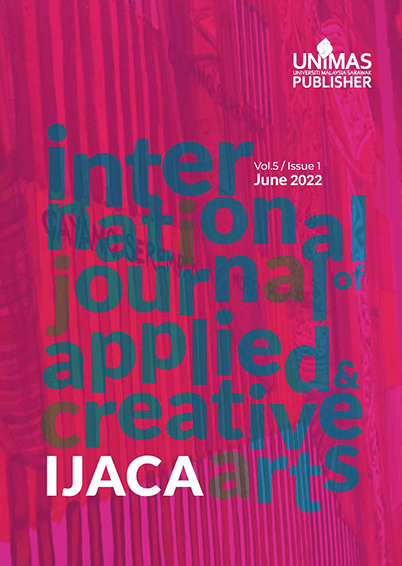DIGITAL PHOTOGRAPHY AND THE FUTURE OF PHOTOGRAPHY CULTURE
DOI:
https://doi.org/10.33736/ijaca.4664.2022Keywords:
Photography; Digital Photography; Digital visual culture; aesthetic; Visual artAbstract
This paper aims to review the current situation on how Photography has completely changed the way we see and engage with the world. The shift from analogue to digital Photography significantly impacted how an analogue photographer perceives the photo process. In the age of these diverse prosumers, the distinction between artists, media professionals, and amateurs may still denote varying degrees of craftsmanship. However, it no longer indicates the inherent technical or aesthetic quality of the results or the likely size of an audience. The impacts give the impression that the aesthetics and attention of Photography provided revolution change in the society of arts and Photography. From this perspective, Photography has first been chemical, then optical and now computational. The changing identities of Photography herein are not simply ontological transformations but also errant modes of perceiving the medium.
References
Badrolhisham, T. (2003). Polimik Lagi! In R.A. Aminullah (Ed.) (Ed.), Contemporary Visual Arts Discourse (p. 81). Perak: Yayasan Kesenian Perak.
Barthes, R. (2001). Camera Lucida: Reflections on Photography. In Reading Images.
https://doi.org/10.1007/978-1-137-08886-4_6
Benjamin, W. (2010). The work of art in the age of mechanical reproduction. Prism Key Press.
Castells, M., & Wiley InterScience (Online service). (2010). The rise of the network society (2nd edition). Wiley-Blackwell.
Faizal, S. (2012). Faizal Sidik: Mahu Kemana Sejarah dan Masa Depan Fotografi Malaysia Kini? Retrieved January 15, 2019, from http://faizalsidik.blogspot.com/2012/12/mahu-kemana-sejarah-dan-masa-depan.html
Flusser, V. (1986). The Photograph as Post-Industrial Object: An Essay on the Ontological Standing of Photographs. Leonardo, 19(4), 329-332.
https://doi.org/10.2307/1578381
Kellerer, S. (2014). REWORDING THE PAST: THE POSTWAR PUBLICATION OF A 1938 LECTURE BY MARTIN HEIDEGGER. Modern Intellectual History, 11(3), 575-602.
https://doi.org/10.1017/S1479244314000195
Kracauer, S., & Levin, T. Y. (1993). Photography. Critical Inquiry, 19(3), 421-436. Retrieved from http://www.jstor.org/stable/1343959
https://doi.org/10.1086/448681
Lughi, G., & Giulio. (2014). Digital Media and Contemporary Art. Mimesis Journal, (3, 2), 43-52.
https://doi.org/10.4000/mimesis.686
McLuhan, M., & Gordon, W. T. (2015). Understanding Media: The Extensions of Man (Critical E). Berkeley: Calif: Gingko Press.
Odenthal, K. (2017). The Impact of Social Media on Photography as an Art | FeltMagnet. Retrieved December 31, 2018, from https://feltmagnet.com/photography/The-Impact-of-Social-Media-on-Photography-as-an-Art.
Popova, M. (2013). Susan Sontag, photography, and social networking. Retrieved October 3, 2019, from Future tense website: https://slate.com/technology/2013/10/susan-sontag-photography-and-social-networking.html
Sokolowsky, J. (2017). Art in the Instagram age: How social media is shaping art and how you experience it | The Seattle Times. Retrieved January 9, 2019, from https://www.seattletimes.com/entertainment/visual-arts/art-in-the-instagram-age-how-social-media-is-shaping-art-and-how-you-experience-it/
Yawnick, M. (2015). A History of Iphoneography. Retrieved January 7, 2019, from https://timeglider.com/timeline/db78f796da1dd667
Downloads
Published
How to Cite
Issue
Section
License
Copyright Transfer Statement for Journal
1) In signing this statement, the author(s) grant UNIMAS Publisher an exclusive license to publish their original research papers. The author(s) also grant UNIMAS Publisher permission to reproduce, recreate, translate, extract or summarize, and to distribute and display in any forms, formats, and media. The author(s) can reuse their papers in their future printed work without first requiring permission from UNIMAS Publisher, provided that the author(s) acknowledge and reference publication in the Journal.
2) For open access articles, the author(s) agree that their articles published under UNIMAS Publisher are distributed under the terms of the CC-BY-NC-SA (Creative Commons Attribution-Non Commercial-Share Alike 4.0 International License) which permits unrestricted use, distribution, and reproduction in any medium, for non-commercial purposes, provided the original work of the author(s) is properly cited.
3) For subscription articles, the author(s) agree that UNIMAS Publisher holds copyright, or an exclusive license to publish. Readers or users may view, download, print, and copy the content, for academic purposes, subject to the following conditions of use: (a) any reuse of materials is subject to permission from UNIMAS Publisher; (b) archived materials may only be used for academic research; (c) archived materials may not be used for commercial purposes, which include but not limited to monetary compensation by means of sale, resale, license, transfer of copyright, loan, etc.; and (d) archived materials may not be re-published in any part, either in print or online.
4) The author(s) is/are responsible to ensure his or her or their submitted work is original and does not infringe any existing copyright, trademark, patent, statutory right, or propriety right of others. Corresponding author(s) has (have) obtained permission from all co-authors prior to submission to the journal. Upon submission of the manuscript, the author(s) agree that no similar work has been or will be submitted or published elsewhere in any language. If submitted manuscript includes materials from others, the authors have obtained the permission from the copyright owners.
5) In signing this statement, the author(s) declare(s) that the researches in which they have conducted are in compliance with the current laws of the respective country and UNIMAS Journal Publication Ethics Policy. Any experimentation or research involving human or the use of animal samples must obtain approval from Human or Animal Ethics Committee in their respective institutions. The author(s) agree and understand that UNIMAS Publisher is not responsible for any compensational claims or failure caused by the author(s) in fulfilling the above-mentioned requirements. The author(s) must accept the responsibility for releasing their materials upon request by Chief Editor or UNIMAS Publisher.
6) The author(s) should have participated sufficiently in the work and ensured the appropriateness of the content of the article. The author(s) should also agree that he or she has no commercial attachments (e.g. patent or license arrangement, equity interest, consultancies, etc.) that might pose any conflict of interest with the submitted manuscript. The author(s) also agree to make any relevant materials and data available upon request by the editor or UNIMAS Publisher.

